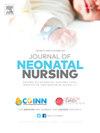Developing the “Internet Plus Newborn Care” Model and its efficacy on newborn outcomes and family satisfaction of newborns care in remote mountainous areas
Q2 Nursing
引用次数: 0
Abstract
Background
“Internet Plus Nursing Services” are expected to be applied throughout China, especially in remote mountainous areas.
Purpose
This study aims to develop “Internet Plus Newborn Care” model and to evaluate its effectiveness on newborn outcomes as well as family satisfaction.
Methods
Using participatory action research (PAR), the “Internet Plus Newborn Care” Model was developed and its efficacy assessed. Nineteen professionals participated in the development of the “Internet Plus Newborn Care” model, while seventy newborn caregivers in Lincang from January to December 2023 participated in an evaluation of the model's efficacy. The intervention group was provided with ‘Internet Plus Newborn Care’ model, whereas the control group received standard care. Newborn outcomes and family satisfaction were assessed. The data were analyzed by using descriptive statistics and Chi-square test.
Results
The “Internet Plus Newborn Care” model was developed based on the concepts of “Internet Plus Nursing Services” and “Home Care or Newborns”. Comparing with the control group, the intervention group had a significantly higher exclusive breastfeeding rate (77.1 % vs. 31.4 %, p = 0.0001) and lower rate of umbilical cord stump infection (2.8 % vs. 14.3 %, p = 0.027 at one month after birth. Although family satisfaction was higher in the intervention group, the difference between the two groups was not statistically significant (p > 0.05).
Implications for practice and research
These results suggest that this developed “Internet Plus Newborn Care” model should be encourage in remote mountainous areas. Moreover, it also should be conducted for long term follow-up and evaluate other newborn outcomes.
发展“互联网+新生儿护理”模式及其对偏远山区新生儿护理结局和家庭满意度的影响
“互联网+护理服务”有望在全国范围内推广,尤其是在偏远山区。目的建立“互联网+新生儿护理”模式,并评估其对新生儿结局和家庭满意度的影响。方法采用参与式行动研究(PAR),建立“互联网+新生儿护理”模式,并对其效果进行评估。19名专业人员参与了“互联网+新生儿护理”模式的开发,临沧市70名新生儿护理人员于2023年1月至12月参与了该模式的疗效评估。干预组采用“互联网+新生儿护理”模式,对照组采用标准护理。评估新生儿结局和家庭满意度。采用描述性统计和卡方检验对资料进行分析。结果基于“互联网+护理服务”和“新生儿居家护理”的理念,构建了“互联网+新生儿护理”模式。干预组产后1个月纯母乳喂养率明显高于对照组(77.1%比31.4%,p = 0.0001),脐带残端感染率明显低于对照组(2.8%比14.3%,p = 0.027)。虽然干预组的家庭满意度较高,但两组间差异无统计学意义(p >;0.05)。实践与研究启示:研究结果表明,“互联网+新生儿护理”模式应在偏远山区推广。此外,还应进行长期随访和评估其他新生儿结局。
本文章由计算机程序翻译,如有差异,请以英文原文为准。
求助全文
约1分钟内获得全文
求助全文
来源期刊

Journal of Neonatal Nursing
Nursing-Pediatrics
CiteScore
2.00
自引率
0.00%
发文量
143
期刊介绍:
Aims & Scope: This is the practical, bimonthly, research-based journal for all professionals concerned with the care of neonates and their families, both in hospital and the community. It aims to support the development of the essential practice, management, education and health promotion skills required by these professionals. The JNN will provide a forum for the exchange of ideas and information between the range of professionals working in this field; promote cooperation between these professionals; facilitate partnership care with families; provide information and informed opinion; promote innovation and change in the care of neonates and their families; and provide an education resource for this important rapidly developing field.
 求助内容:
求助内容: 应助结果提醒方式:
应助结果提醒方式:


